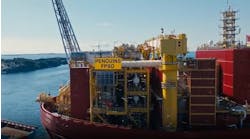John Waggoner
Technology Editor, Drilling & Production
HOUSTON -- Brazilian national oil company Petrobras continues to raise oil and gas production with the recent start-up of three offshore platforms. In March, the company set a new daily oil production record of 2,012,654 boe, beating its previous record from Dec. 25, 2007, and output keeps ramping up. Officials now see year-end production climbing to 2.8 MMb/d reaching 3.7 MMb/d by 2013 and as much as 5.8 MMb/d by 2020.
The record production was due mostly to the start up ofP-51 and Cidade de Niteroi in the Marlim Sul field, and P-53 in Marlim Leste, all in the Campos basin. Other platforms are also said to be performing well, especially P-52 and P-54, Offshore has learned.
The production drive has included some daring moves by Petrobras, including the recent development of deepwater carbonatic reserves once thought too permeable and porous to retain reservoir quality beyond shallow waters.
The operator, which already exploits shallower carbonatic reservoirs in Campos, discovered via 3D seismic data a few years back that similar formations had apparently "slid" into deeper water over millions of years.
In February, the well 7-MLL-54HP, called Jabuti, began producing at a water depth of 1,413 m (4,636 ft). With an initial flow of 35,000 b/d, Jabuti was the first well to be connected to FPSOCidade de Niteroi.
Jabuti represents the first commercial light oil (29° API) accumulation ever discovered in deepwater carbonatic reservoirs, proving these formations can still accumulate and retain oil at such depths. The gamble could pay off for Petrobras, since the similar new discoveries in deeper areas of Campos can now be exploited with the advantages of a well established production structure already installed in the basin.
The key to Brazil's emergence as a major producer will be the presalt reserves. However, this requires additional innovation to master the problems posed by current limits of visualization technology and the risks of drilling through the salt.
First presalt oil is now expected around early May from the Tupi field in the Santos basin. The start of long term tests at Tupi will progressively ramp up through 2010 and provide more assurance about the presalt program.
Separately, in March, energy officials accompanied a state visit to Washington, adding to speculation that development of Brazil's presalt reserves could begin to overshadow Venezuela's role as chief regional oil exporter to the US.
Petrobras CEO Jose Sergio Gabrielli told Brazilian legislators after the visit that Brazil is getting closer to joining the ranks of major global producers such as Russia and Saudi Arabia. The presalt areas of Brazil contain untold amounts of hydrocarbons with some estimates ranging to as much as 80 Bbbl of light oil.
Within a decade Petrobras presalt production should hit 1.8 MMb/d, Gabrielli says. However, the true size of these reserves remains an intriguing puzzle that can be cracked only through a better understanding of the presalt geology.
03/26/2009


